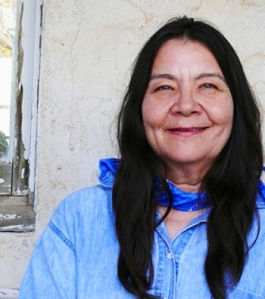
A striking man with venomous charisma to whom we raise our pens on this day of his birth. Source: News From Indian Country
This is the third in a continuing series of posts celebrating the birthdays of important Native authors. As today’s author indicates, I include authors of all forms whether literary, academic, or both (as so many of our finest Native novelists are). If you have any important folks you want to make sure I don’t miss, drop me a line!
How to begin to talk about Vine Deloria Jr.? The entire Deloria family, dynasty if you will, is such a force in Indian Country with their work in the church, the academy, the national pan-tribal organizations etc., that to speak of one you feel have to speak of them all and the work they have done with and for Native peoples. However, since it’s not all of their birthdays, though a national Deloria day may not be a bad idea, I will restrict myself to talking about Vine.
Vine was born in 1933 near the Pine Ridge reservation into a family of Episcopalian and tribal leaders of the Yankton Band of the Dakota Nation. Like the many professions represented in his family, Vine played around with a few career possibilities throughout his early life, going to school to become an minister, then completing a degree in science and later receiving a law degree. He published his first book in 1969 and has produced a fairly steady stream of writings ever since his death in 2005, while also having served on the boards of numerous Native organizations such as the National Congress of American Indians and the National Museum of the American Indian. Like I said the Delorias are not mere people, they are a force.
You can tell a lot about Vine Deloria Jr. from the titles of his works. The most famous of which is Custer Died For Your Sins: An Indian Manifesto. This is the first book we cracked open in my Critical Indigenous Studies class and for me, as well as many others, it cracked up what exactly critical indigeneity meant. And that was just the first in a long line of thoughtful polemics and biting titles. There’s also We Talk, You Listen; Red Earth, White Lies; God is Red; and Genocide of the Mind. As you might tell, he is quite a master zing artist interjecting his works with precise phrases that strike at the heart of White-Indian relations.
Some of his favorite targets are anthropologists, new agers, naive Americans (to be honest, the majority, believers of the Bering Strait Theory, and of course the BIA. He has also written extensive tracts on religion, philosophy and the philosophy of religion. The dude has a lot to say and he says it well. I was trying to avoid turning this post into a “Best Quotes of Vine Deloria” but I just can’t resist. Rather than blabber about what a good writer is, I will break the golden rule of good writing by just telling you what Deloria is all about instead of trying to somehow show you through my own inept words. I will say that the common thread throughout these quotes is Deloria’s mission to destroy the preconceived people have not only about Indians but also about the natural supremacy of Western civilization and American exceptionalism. He was not afraid to say that tribal methods of being
Deloria On Anthropologists:
Indians are equally certain that Columbus brought anthropologists on his ships when he came to the New World. How else could he have made so many wrong deductions about where he was?
Deloria on the theory that the Sioux are natural warriors unable to survive in the modern day:
Some Indians, in a tongue-in-cheek manner for which Indians are justly famous, suggested that a subsidized wagon train be run through the reservation each morning at 9 a.m. and the reservation people paid a minimum wage for attacking it.
Deloria on the “plight” of Indians:
One of the finest things about being an Indian is that people are always interested in your “plight.” Other groups have difficulties, predicaments, quandaries, problems, or troubles. Traditionally we Indians have had a “plight.”
Deloria on the white man:
The white man must no longer project his fears and insecurities onto other groups, races and countries. Before the white man can relate to others he must forgo the pleasure of defining them. The white man must learn to stop viewing history as a plot against himself.
Deloria on Western Civilization:
Western civilization, unfortunately, does not link knowledge and morality but rather, it connects knowledge and power and makes them equivalent.
Deloria on the idea that “we are all immigrants”:
Yes, indeed but it makes one helluva difference whether you came 100,000 years ago, or just out of a boat steerage a generation back.
There are many, many more on the nature of sovereignty, harmful government policies, the civil rights movement, etc but we have to stop somewhere.
Happy Birthday, Vine Deloria. You are very missed here on the Red Earth.

